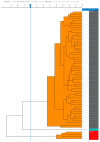Fourier Transform Infrared Spectroscopy Application for Candida auris Outbreak Typing in a Referral Intensive Care Unit: Phylogenetic Analysis and Clustering Cut-Off Definition
- PMID: 39065082
- PMCID: PMC11279149
- DOI: 10.3390/microorganisms12071312
Fourier Transform Infrared Spectroscopy Application for Candida auris Outbreak Typing in a Referral Intensive Care Unit: Phylogenetic Analysis and Clustering Cut-Off Definition
Abstract
Recently Candida auris has emerged as a multi-resistant fungal pathogen, with a significant clinical impact, and is able to persist for a long time on human skin and hospital environments. It is a critical issue on the WHO fungal priority list and therefore it is fundamental to reinforce hospital surveillance protocols to limit nosocomial outbreaks. The purpose of this study was to apply Fourier transform infrared spectroscopy (FT-IR) to investigate the phylogenetic relationships among isolated strains from a C. auris outbreak at the University Intensive Care Unit of a Tertiary University hospital in Turin (Italy). To calculate a clustering cut-off, intra- and inter-isolate, distance values were analysed. The data showed the presence of a major Alfa cluster and a minor Beta cluster with a defined C. auris clustering cut-off. The results were validated by an external C. auris strain and Principal Component and Linear Discriminant Analyses. The application of FT-IR technology allowed to obtain important information about the phylogenetic relationships between the analysed strains, defining for the first time a "not WGS-based" clustering cut-off with a statistical-mathematical approach. FT-IR could represent a valid alternative to molecular methods for the rapid and cost-saving typing of C. auris strains with important clinical implications.
Keywords: Candida auris; Fourier transform infrared spectroscopy; IR-biotyper; cluster analysis; healthcare-associated infections; multi-resistant fungal pathogen; outbreak; phylogenetic analysis.
Conflict of interest statement
Author Miriam Cordovana was employed by the company Bruker Daltonics GmbH & Co. KG. The remaining authors declare that the research was conducted in the absence of any commercial or financial relationships that could be construed as a potential conflict of interest.
Figures






References
-
- Vatanshenassan M., Boekhout T., Mauder N., Robert V., Maier T., Meis J.F., Berman J., Then E., Kostrzewa M., Hagen F. Evaluation of Microsatellite Typing, ITS Sequencing, AFLP Fingerprinting, MALDI-TOF MS, and Fourier-Transform Infrared Spectroscopy Analysis of Candida Auris. J. Fungi. 2020;6:146. doi: 10.3390/jof6030146. - DOI - PMC - PubMed
LinkOut - more resources
Full Text Sources

